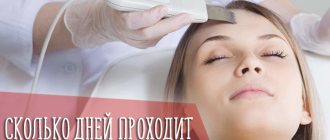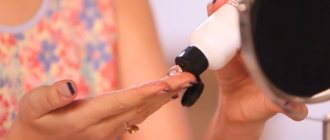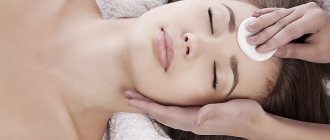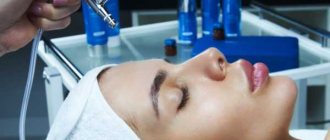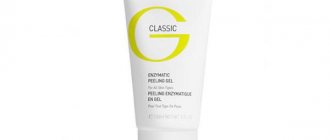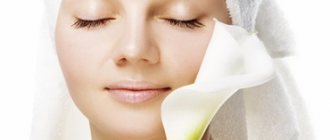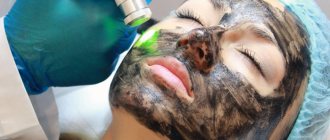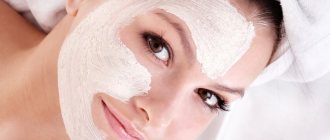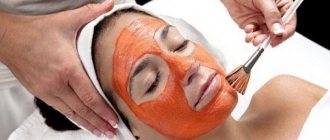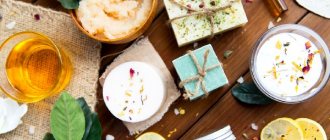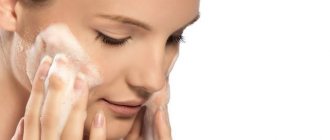Useful trace elements, minerals, vitamins, pectins and polyphenols make the apple one of the most valuable ingredients used in home cosmetology. And apple cider vinegar, which is part of the fruit, allows you to create effective cleansing products, one of which is apple peeling . The procedure can be carried out not only in the salon, but also at home. The astringent, drying and soothing effect of the compositions accelerates cellular regeneration and exfoliation of the stratum corneum of the epidermis.
Description of peeling
The apple contains many useful trace elements, minerals and various polyphenols, pectins, vitamins and other substances, so it is considered one of the healthiest fruits for humans. One of the substances included in its composition is apple cider vinegar, the properties of which make it possible to successfully use cosmetic preparations made from apples to cleanse the skin.
The effect of apple cider vinegar on the skin has an astringent, drying and soothing effect; when applied to the skin, old cells are exfoliated and young cells are intensively regenerated.
In general, apple peeling is a special case of fruit peeling, in which the concentration of malic acid, among other fruit acids, is 10%-15%. At the same time, peeling with malic acid is characterized by moderate results in smoothing out deep wrinkles and scars, but effectively helps in polishing and evening out the complexion and increasing the firmness and elasticity of the skin.
Cleaning steps
Before you start cleansing your face with peeling, let's look at what it includes, and where is the best place to start:
- Preparing for the procedure . If you decide to cleanse your facial skin with apple cider vinegar, then two weeks before, avoid any scrubs or other types of peeling. This must be done in order for the cleansing process to proceed correctly without complications.
- Peeling .
So, the time has come for the procedure. Before you start, you need to prepare the skin, namely, clean it of various contaminants and keratinized areas. You can also pre-steam your face to make the peeling effect better. Then you need to wipe it with lotion. Next, apply selected apple cider vinegar to problem areas and wait the required amount of time. At the time of cleaning, a slight tingling and burning sensation is possible - this means that everything is going as it should. - Post-procedure care. After peeling, local redness of the skin is possible, and exfoliation of keratinized skin may begin within 24 hours. This is normal, this is how the cleansing process happens.
Remember that until the skin recovers on its own, it is not advisable to touch your face not only with sponges, but also with your hands. The use of scrubs is strictly prohibited.
Therefore, for the first two or three days it is necessary to take care of it, that is, daily cleaning of dirt and applying a moisturizer. During peeling, it would be more rational to use aloe gels. This is necessary so that the loose particles of old skin do not stick and “clog” your face again.
To make the cleansing effect even better, you can add a couple of drops of vinegar to the water for washing. This will help keep the epidermal cells in good shape and avoid the recurrence of rashes.
Properties of the active component
The active ingredient, as mentioned above, is malic acid.
(aka malonic acid, hydroxysuccinic acid, E296, malic acid). It is obtained from fruits (unripe apples, grapes, rhubarb, rowan fruits, barberries, gooseberries and raspberries) or synthetically.
Malic acid is an intermediate metabolic product in living organisms. In the glyoxylate and tricarboxylic acid cycles and during gluconeogenesis, malic acid is formed in the form of malate. Under the influence of enzymatic reactions, malate can be converted into oxaloacetate, fumarate, and pyruvate.
Action of malic acid:
1. antioxidant 2. capillary strengthening 3. keratolytic 4. hydration 5. immunostimulating 6. Bacteriostatic and anti-inflammatory 7. Regenerative 8. restores the lipid layer of the skin.
Malic acid is found in apple cider vinegar, which is widely used for at-home peeling. Apple cider vinegar is an excellent acidity regulator for the skin. By noticeably shifting its acid-base balance towards increasing acidity, it demonstrates antibacterial properties, creating conditions that suppress the activity of harmful bacteria, viruses and fungi. This way you can get rid of skin irritation and inflammation. At the same time, restoration of the acid-base balance of the skin and its natural protective functions after the apple peeling procedure occurs in a short time (in most cases, no more than one week) by itself. Exposure to apple cider vinegar also leads to the disappearance of acne and clearing of pores.
Apple cider vinegar contains a large number of amino acids, so it helps to launch mechanisms of intensive cell regeneration, increased collagen production, protection from the harmful effects of free radicals, as well as replenish the deficiency of useful substances in skin cells, including vitamins (A, B1, B2, B6 , C and E), acids (lactic, citric, malic, oxalic), trace elements (potassium, calcium, magnesium, sodium, iron, silicon, copper, sulfur, phosphorus) and enzymes.
Carrying out fruit peeling for the face at home
Fruit peeling is suitable for home use. Professional cosmetics contain more AHA acids. This concentrated drug eliminates problems more effectively.
Those products that are sold in stores have a lower concentration of active substances than their counterparts in specialized salons.
Interesting fact: by undergoing one to three sessions of fruit peeling in a cosmetology salon, you can eliminate many facial skin problems.
Since specialized cosmetics contain a larger amount of AHA acids, there is a risk of side effects after their use.
Products for home use are less aggressive. However, to eliminate the problem, they must be used regularly. Homemade masks should not contain more than 25% fruit acid. It is recommended to apply the product in the evening, when the skin better perceives beneficial substances.
Indications and contraindications
Indications
1. Hyperpigmentation 2. Chrono and photoaging 3. rosacea and telangiectasia 4. General skin atony (flabby, flabby and sagging skin) 5. Hyperkeratosis (slow process of exfoliation of cells of the stratum corneum) 6. Mild form of acne to soften comedones and normalize sebum secretion
Contraindications
1. Allergy to one of the components of the peeling composition 2. Herpes in the acute stage 3. Pregnancy and lactation 4. Damage to the skin 5. Neoplasms 6. Skin diseases 7. Acute inflammatory diseases 8. Chronic diseases in the acute stage
Cosmetic face masks - good basic skin care
Shilpi Khetarpal considers cleansing, daily use of sunscreen and moisturizing to be the basis of facial skin care, and a face mask harmoniously complements these procedures.
Face masks “push” the ingredients they contain into the layers of the skin, filling pores and allowing the skin to absorb more product. When properly selected and used, they give a good effect.
Industrial face masks are great for soothing inflamed skin, so they can be used after cosmetic procedures and eliminate the effects of prolonged exposure to the sun. They also have a moisturizing effect. There are options designed for specific skin problems, such as acne or wrinkles.
Therefore, Shilpi Khetarpal considers face masks to be excellent basic care. However, for serious problems, for example, widespread acne or pronounced age-related changes, in addition to masks, other treatment methods are needed, which can only be obtained in specialized centers and clinics.
Face masks
Pros and cons compared to other types of peeling
pros
One of the main advantages of apple peeling is the ability to use it at any time of the year. It is useful and effective for any age group, is used for people with problematic and sensitive skin, and is indicated for rosacea.
Apple peeling contains no mechanical abrasives. The cleansing process occurs due to the softening of the bonds between the cells of the stratum corneum and the epidermis, which is a consequence of the effects of acid.
Apple peeling effect
1. Complexion is evened out, redness is removed 2. Pigment spots are reduced 3. The acidic pH of the skin is restored 4. Small wrinkles are smoothed out 5. The skin becomes smooth and soft 6. Skin turgor and elasticity increases
Minuses
Since apple peeling is light, superficial, it has a less pronounced effect compared to other peels (glycolic, salicylic), it will not remove wrinkles and scars.
What is a fruit peeling for the face?
Not long ago it was noticed that fruit acids have beneficial properties. They began to be used in various branches of medicine. But only after a considerable period of time did fruit acids begin to be used in cosmetology.
Another abbreviated name for these elements – AHA acids – is derived from the full “alphahydroxy acid”. These substances help:
- make facial skin lighter;
- remove excess pigmentation;
- even out complexion.
If you use fruit acids, you can eliminate many skin problems. Scientists have proven that AHA acids can prevent the appearance of natural signs of skin aging. Such signs primarily include wrinkles and loss of tone.
Preparation of apple peeling
Homemade apple cider vinegar is the most effective.
In this case, you can guarantee the presence of beta-carotene, which is a natural antioxidant that neutralizes free radicals, as well as vitamins, amino acids, pectins and enzymes. There are several recipes for making apple peeling at home.
For example, apple cider vinegar is diluted in water in a ratio of 1:8 and cloves and lavender are added. The resulting mixture is infused for a week in a dark place, with occasional shaking. The resulting peeling solution is stored at low temperature (in the refrigerator). You can also use honey (1 tablespoon), fine salt (1 teaspoon) and apple cider vinegar (1 tablespoon) to prepare apple peeling. All these components are mixed and the resulting mixture is immediately ready for the procedure. Another simple recipe for making an apple peel that is immediately usable is to mix two tablespoons of apple cider vinegar with 0.5 liters of water. In addition, many cosmetic companies produce ready-made apple peels. In many cases, they are made with the addition of various auxiliary substances that improve the effectiveness and expand the range of action of the procedure. For example, sugar cane and maple fruit extract moisturize and achieve a calming effect, while deeper cleansing is provided by extracts of papaya, orange, gypsophila root and blueberry, a calming effect due to calendula flowers, and an antioxidant effect due to the addition of wild apple extract.
What acids are used for peeling?
- Glycolic
Sugar cane and green grapes are rich in this acid. The substance has a very low molecular weight, which means that it can easily penetrate the dermis and cause a response. This AHA acid is most in demand in cosmetology. It is usually used alone or in combination with other fruit and non-fruit acids.
The action of glycolic acid occurs at the level of the epidermis. The substance activates the production of collagen protein, which affects the structure of the skin tissue. That is why the glycolic variety is called remodeling peeling.
- Dairy
This acid is produced by Lactobacillus bacteria. Lactic acid is found in sour milk, apples, grapes, tomatoes, blueberries and some other berries. In addition, it is included in the natural moisturizing factor (NUF). This acid has a slight exfoliating and moisturizing effect. It is recommended for use on sensitive and dry skin.
- Almond
This acid is obtained from sweet almond grains. It has a mild effect. Mandelic acid can be purchased for professional fruit peeling of the face. In addition, it is included in home cosmetics used for regular care.
- Apple
It is found in large quantities in apples and tomatoes. It is often used to lightly exfoliate epidermal cells.
- Wine (tartar)
This acid is present in grapes, wine, and oranges. The substance exfoliates, whitens and moisturizes.
- Lemon
Found in lemons and other citrus fruits, as well as pineapples. This acid is the heaviest of all fruits. The main quality for which it is valued is its whitening effect (especially in combination with tartaric acid). In addition, citric acid is endowed with antioxidant properties.
- Phytic
Contained in cereals (rice husks, quinoa). Has a mild exfoliating effect.
Pre-peeling preparation
The first stage of pre-peeling preparation of facial skin for the procedure is makeup removal and cleansing of the skin. To do this, use a cleansing foam or gel for washing. Then the skin is degreased and toned using lotion according to skin type. When using peeling at home (low malic acid content), you can steam your face to facilitate the process of removing dead skin. To do this, you can direct a stream of hot water from the shower into your face or use a terry towel soaked in hot water and slightly wrung out - it is applied to your face and left for 30 seconds. This procedure is performed several times until the skin is moderately steamed.
How many fruit peeling procedures are needed to achieve results?
As a rule, the fruit peeling procedure (pictured above) is prescribed by a doctor after examining the patient’s complaints about the condition of the facial skin.
In some cases, you may need only one session rather than a course, which is an undoubted advantage of peeling using fruit acid.
Below is a table with a classification of all possible skin problems and the number of sessions that need to be performed (depending on the client’s age).
The number of manipulations may vary depending on the patient’s age and the individual characteristics of his skin.
- Types of acid-fruit peeling
The depth of effect of fruit peeling is affected by the acid concentration and pH of the peeling solution. Moreover, the lower the pH (the more acidic the solution), the more intense the effect of the acid.
- Superficial fruit peeling
For superficial fruit peeling, glycolic, lactic, malic, tartaric or citric acid is used. This procedure can be done at home. As a rule, superficial fruit peeling is useful for the following problems:
- aging skin;
- some forms of acne;
- excessive pigmentation.
The procedure helps smooth the skin and accelerate regeneration processes in epidermal cells. As a result of this peeling, the skin acquires a healthy appearance.
Superficial fruit peeling cannot be done if you have:
- allergy;
- inflammatory processes;
- damage to the epidermis.
- Medium fruit peeling
It must be kept in mind that this type of peeling must be performed by an experienced cosmetologist. The result obtained after this procedure is more noticeable compared to the effect of superficial peeling.
Medium fruit peeling is effective for:
- natural aging of the skin;
- presence of scars;
- hyperkeratosis;
- excessive pigmentation.
Cosmetologists advise regularly using this type of peeling after 35 years. It is not recommended to do it in summer. Fruit peeling can be performed not only on the face, but also in the décolleté, neck, and thighs.
The procedure is contraindicated for:
- herpes;
- hypertension;
- epilepsy;
- hyperpigmentation.
Redness after a medium fruit peel can last for a week.
- Deep fruit peeling
This type of peeling is carried out only in a specialized salon, because this procedure is dermatosurgical.
It is usually used if there are problems:
- hyperkeratosis;
- deep wrinkles or noticeable scars;
- pigmentation.
Deep fruit peeling is contraindicated for:
- pregnancy;
- herpes;
- diabetes mellitus;
- the presence of damage and inflammatory processes on the skin;
- diseases of internal organs.
Important! This procedure can only be performed with the permission of a doctor.
The skin will recover over several months.
Stages of apple peeling
In salons, apple peeling most often includes other soft fruit acids (mandelic and lactic), the total acid content is about 25%. The peeling mixture is applied with a fan brush to the face, neck and area around the eyes. Exposure time 10 minutes. Then neutralization is carried out according to the protocol using a special alkaline agent or water).
Apple peelings for home use are presented in the form of gommage. Peeling gommage is applied in an even thin layer to the skin of the face and neck, except for the paraorbital zone and the lip area. When the composition dries (after about 1-2 minutes), you need to roll the gommage into pellets with light circular movements. You should start applying the product from the chin area along the massage lines upward. To do this, apply a small amount of peeling from the tube to your fingers, lightly stretch the skin with one hand, and use the middle and ring fingers of the other to make circular movements. When you have rolled up all the product, wipe your face with warm water and toner.
Another way to perform the procedure is to apply a cotton or linen napkin soaked in self-prepared apple peeling to your face. In this case, the area of their contact should be maximum. This operation is repeated for normal skin for 10 - 15 minutes at intervals of 1 - 2 minutes. Oily, porous skin requires a longer procedure, while dry and sensitive skin requires a minimum number of operations. The final step is to wash your face with warm water and massage it with a terry towel along the massage lines with light movements to finally free the surface of the skin from dead cells. After this, the face is rinsed generously with water, lightly blotted with a towel and moisturizer is applied to it. The slight redness of the face that occurs after the procedure completely disappears after 20 minutes.
The final step in all cases is to apply cream according to your skin type and it is advisable to use a sunscreen with SPF of at least 20.
Number of procedures
The frequency of the procedure for oily and normal skin is 2 times a week, and for dry and sensitive skin – 1 time a week. A course of 10-15 procedures.
Reviews from patients and advice from cosmetologists
Since this type of peeling is very popular among women of different ages and many of them have tried it on themselves, the discussion on this issue is quite lively. They are ready to share not only their impressions and results, but also give the necessary advice:
- For example, Annet recommends strictly observing the proportions, otherwise various injuries may occur (burns, skin damage, etc.).
- And Milao doesn't really trust homemade peeling products. She says it's better to go to a salon and get a cleansing procedure done there, as only a professional peeling can solve your problems.
- Dariya, on the contrary, constantly uses apple peeling and is very pleased. Her skin after the procedure becomes soft, silky and elastic.
There are also different opinions among cosmetologists: some do not consider peelings using apple cider vinegar to be effective, while others, on the contrary, support those who use this method to cleanse their facial skin. Many of them use materials based on the same acetic acid to carry out peeling programs.
For more serious cleansing programs - intermediate ones - you should only contact specialists ; in no case should you do such manipulations at home, otherwise there will be unpleasant consequences.
So, as we see, using peeling with apple cider vinegar is a completely accessible, inexpensive and effective means of cleansing the facial skin of dead skin particles. The main advantage of this method is that you can do it yourself at home at any time convenient for you.
Apple cider vinegar has a very gentle effect on the epidermis and cleanses it without causing any problems, so you get a renewed, fresh and beautiful face.
Possible complications after apple peeling
When using apple peeling on dry skin, there is a high probability of it drying out, so throughout the course you should carefully monitor the condition of the skin and use moisturizers. Apple peeling is superficial and does not cause serious complications; no peeling is observed. In rare cases, dry, sensitive and thin skin may cause slight flaking in the cheek area, itching and red spots. You should use a series of cosmetics for sensitive skin prone to irritation in your home care.
Facial hyperemia is possible, which goes away on its own for the first few hours after peeling. Creams with soothing ingredients should be used. An exacerbation of herpes is also possible. Prophylaxis should be carried out before performing the procedure.
Also, do not forget about the intolerance of some skin types to acids. To determine this, apply a small amount of peeling to a sensitive area of skin, such as the wrist, and wait a couple of minutes before rinsing. If redness or irritation occurs in this area, it is better to avoid using apple peeling. If it gets into your eyes, rinse them immediately with water. If the recommended dosage or exposure time is exceeded, peeling, itching and red spots may occur.
Possible side effects when using fruit peeling
Most clients tolerate the procedure without problems. Almost no one has any painful reactions from the body (except for a slight burning sensation of the skin).
But it should still be noted that in some cases side effects may occur. In addition, judging by customer reviews, there are some among them who have experienced negative consequences.
The main side effects are an allergic skin reaction to any element of the solution or a minor burn. These phenomena are infrequent and in most cases occur due to the incorrect dosage of the drug, its inconsistency with the skin type, and the unprofessionalism of the cosmetologist.
Negative consequences can be avoided if you strictly follow the specialist’s recommendations and properly care for your skin during the rehabilitation period.
Prices and brands of peelings
The cost of an apple peel will depend on where you will peel it - in a salon or at home. In the salon, you will pay on average from 2000 to 3500 rubles for one procedure. For home use, you can purchase apple peels from different companies; the cost of one jar or tube varies on average from 220 to 600 rubles. The effect of home peelings is much less than that of salon procedures, since they contain a minimal percentage of acid.
Manufacturers of apple peeling
Home series:
1. Apple peeling gel gommage - Apple juicy peeling gel, Mizon (Korea)
2. Massage cream (peeling roll) “Green Apple” - Appletox Smooth Massage Peeling Cream, Tony Moly (Korea)
3. Apple peeling gel - Vov-Apple AHA Peeling gel, VOV (Korea)
4. Peeling roller “Universal Apple” - Spa Technology TianDe, Great Wall Cosmetics Factory (China)
5. Peeling gel with green apple extract - Apple All in One Peeling Gel, Baviphat (Korea)
6. Peeling Green Apple for sensitive skin - Green Apple Peel - Sensitive, Juice Beauty (USA)
Salon peelings:
1. Radiant peeling – Illuminize Peel (Skinmedica, USA)
2. AHA Almond-Apple Peeling 25% – Almond/apple pell lotion, Eldan Cosmetics (Switzerland)
Tags: peeling
Market Analytics
- 2020 in the beauty industry – innovation without borders
- Black Lives Matter movement: reaction and consequences for the beauty industry
- COVID-19 is changing the rules of the game in the cosmetics market
Convenient search for beauty salons on our website
Beauty salons in Moscow Beauty salons in St. Petersburg Beauty salons in Ekaterinburg Beauty salons in Novosibirsk
Latest blog posts on our website
- Naturecream / Arnica - the magical plant of alchemists
- Naturecream / Tremella Extract - Snow Mushroom Detox for Skin
- Prostye-sovety / How to visually enlarge your lips with makeup
- Naturecream / Apricot kernel oil for face
- Naturecream / MATRIXYL3000 - the best skin elasticity stimulator
- Naturecream / SPF in Natural Oils
- Naturecream / Geranium (Pelargonium) oil for skin health and beauty
- Prostye-sovety / Save on a beauty salon: procedures that can be done at home
- Naturecream / Growth Factor - brings back youth?
- Oksana-Lezina / 3 effective abdominal exercises from a fitness instructor for beginners
Latest forum topics on our website
- Natalya / How to properly make a gelatin mask?
- Mrs._Smith / Badly sunburned! What to do?((
- Ice / Is it necessary to combine fitness classes with a diet?
- Antonova / What can be used for hair loss?
- Radio operatorKat / Who was on a protein diet?
Reviews about the procedure
Apple peeling for the face [Leave a review]
Leave your feedback about this procedure (it will appear on this page after moderation)
In this form, describe only
your personal
experience of undergoing the procedure.
In order to leave a comment regarding the content of the article, use another form - in the “comments” block at the bottom of the page.
Other articles in this section
| Acid peeling for face, body and legs Various types of peeling for different parts of the body (face, body, arms, bikini and décolleté, legs) will help your skin acquire a neat, well-groomed appearance. |
| Salicylic peeling for the face Salicylic peeling has a powerful anti-inflammatory, antiseptic and keratolytic effect, it helps to normalize the functioning of the sebaceous glands and narrow pores. This peeling is indicated for young oily skin with minor problems, as well as for mature skin with signs of photo- and bioaging. |
| Croton peeling for the face Croton peeling is a type of chemical peeling that differs from others in the content of crotonic acid in its composition, which is extracted from the seed oil of the Croton tree, which grows on the island of Sri Lanka and in China. Research has proven that the resulting oil noticeably removes not only the appearance of wrinkles, but also evens out the skin texture itself. The population of these territories has long been using this oil for rejuvenation. |
| How to find a good cosmetologist and where is the best place to do peeling The beauty and health of your skin is in your hands, so carefully choose a cosmetologist and the place where the procedure is performed. I wish you to find a good specialist and I hope my advice will help you with this. |
| Coral peeling Rose de Mer for the face Coral peeling is a type of mechanical exfoliation and cleansing of the skin. This method is used in cosmetology clinics and salons as an alternative to harsh chemical peels. Rose de Mer peeling occurs without skin burns, eliminates protein coagulation, but causes painful sensations of varying strength, which manifest themselves individually. With coral peeling, the upper keratinized layers of the epidermis are removed, which allows solving cosmetic problems associated with acne, pigmentation, premature aging, etc. |
| Phytic peeling for the face Peeling with phytic acid in some salons is also called “Hollywood peeling” because it came to us from the USA. It is very popular there, since it can be used at any time of the year and does not require a long rehabilitation period, that is, you can work and appear in public immediately after the procedure. Phytin peeling has proven itself best as a peeling that combats the problems of mature skin with rosacea. |
| Phenol peeling for the face Phenol peels refer to skin exfoliation procedures performed using carbolic acid (phenol). Deep peeling affects all layers of the epidermis, right down to the papillary layer. The extreme length of the rehabilitation period, reaching 12 months in some cases, and the high risk of severe complications require a particularly careful approach. |
| Arginine peeling for the face One of the types of chemical peelings is arginine peeling, which rejuvenates and moisturizes the skin, has a mild exfoliating effect, and prevents the appearance of the inflammatory process. The result is already visible after the first procedure. The skin becomes velvety, matte, elastic, and a healthy complexion appears. |
| Laser skin resurfacing Facial skin resurfacing (dermabrasion) is a deep peeling procedure during which the epidermis and part of the dermis are completely removed. One of the progressive methods of skin resurfacing is to carry out this procedure using a laser. In this case, its radiation leads to complete evaporation and coagulation of soft tissue to the required depth. |
| Jessner peeling for the face Jessner peeling is a cosmetic procedure aimed at improving the condition and appearance of the skin using a special chemical composition. An important feature of this peeling is that, in addition to removing the stratum corneum of the epidermis to a certain depth, it promotes active regeneration of skin cells. Another name for the Jessner peel is “Hollywood”: due to the fact that it is extremely popular among movie stars. |
What kind of fruit peeling can you buy at the pharmacy?
In addition to folk remedies, there are also pharmaceutical preparations that can also be used for home peeling procedures.
- The drug "Bark". The product is positively assessed by many users. Their reviews say that after such peeling, skin defects are eliminated, pores are narrowed, and the oiliness of the skin is reduced. But this product is not recommended for use on sensitive skin.
- Skinlite. A drug that makes the skin velvety and soft. It can be used by owners of any skin type.
- Janssen Inspira M.F.A. The drug is a professional product. Therefore, it can be used by cosmetologists in a specialized salon. Helps smooth out facial unevenness and give the skin more softness and tenderness.
- Revitalift "Laser x3" (L'Oréal Paris). A drug that actively fights skin aging and excessive pigmentation. It contains glycolic and fruit acids, which helps smooth out wrinkles.
- Idealia (Vichy). It belongs to the group of homemade fruit peels and is available in lotion form. You need to apply it with a cotton pad, just like a toner. This fruit peeling for the face, which can be bought at the pharmacy, contains citric and glycolic acids (4% each), HEPES (5%). In addition, the product contains black tea enzyme, which has antioxidant properties, and blueberry extract.
- Glycolic 10 Renew Overnight (SkinCeuticals). The cream contains glycolic (10%) and phytic acids. To improve the tolerability of the drug, the composition includes components with a soothing and moisturizing effect.
- Nightly Refining Micro-Peel Concentrate (Kiehl's). A product containing a composition of fruit acids from plants such as quinoa, blueberries, citrus fruits, sugar maple and sugar cane. Thanks to its exfoliating properties, the drug gradually removes dead cells from the skin, thereby renewing it.
- Visionnaire Crescendo (Lancôme). The peeling course consists of two stages: preparatory and main. The first is treatment with phytic and fruit acids. During the second stage, the skin is exposed to glycolic (10%) and salicylic acids. The effectiveness of this product is lower than that of a professional one. However, it's worth a try.
- Absolue Precious Cells Rose Drop (Lancôme). The composition contains glycolic acid and a cocktail of essential oil and active molecules of rose. If the words luxurious and chic are applicable to peeling, then they are talking about this product.
- Re-Plasty High Definition Peel (Helena Rubinstein). This is a peeling serum with glycolic, phytic, and lactic acids. In addition, the drug contains vitamins A and E.
In the photo below you can see how effective fruit peeling is: before and after.
Some tips for choosing a face mask
Dr. Khetarpal recommends reading the product label and looking for the words “fragrance-free,” “hypoallergenic,” “dye-free and paraben-free.” You should not buy a mask with a lot of chemicals.
Before purchasing products with bee venom, you should consult a cosmetologist. Such cosmetics often cause allergies, so it is better to replace them with a safe alternative.
If you are taking medications, you should consult a cosmetologist before purchasing a face mask. The medications you take may interact with the ingredients in the product. Some medications change the thickness of the skin or make it hypersensitive, all of which can lead to severe irritation and other unwanted effects.
Is it worth chasing the exotic when buying unusual face masks?
Now in cosmetology there is a real “boom” of masks with exotic ingredients, which are credited with miraculous properties. However, Shilpi Khetarpal believes that options with snail mucus, mushroom juice, extracts of exotic plants and other “miracles” are not worth buying. All this exotic stuff often causes severe allergies. Swelling, rash, and even coma may develop.
The unusual and exotic ingredients in some face masks have not been studied in clinical trials. Therefore, they may be ineffective and not worth the high price you have to pay for them.
Such options often contain a large number of unsafe preservatives, parabens, and other undesirable substances that allow the preservation of exotic components. As a result, instead of a beneficial effect, you can get inflammation.
Therefore, a regular face mask, the composition of which is clear and familiar, is much more effective. The risk of allergies and other complications in this case is much lower.
Which masks are suitable for different facial problems?
Ingredients to look for on the label for various skin problems:
- Dryness – hyaluronic acid.
- Too thin sensitive skin - vitamin C, vitamin E, resveratrol and ferulic acid.
- Acne, blackheads, increased sebum production - salicylic acid and alpha hydroxy acids (AHAs).
- Rosacea (rosacea) – niacinamide.
- Dark spots and pigmentation – soy, kojic acid, tranexamic acid, licorice root extract.
